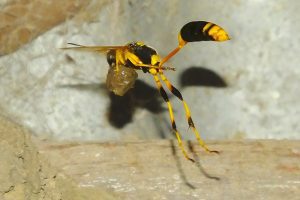Mud Dauber Wasps – Unsightly Nests But Little Threat
By Chris Williams on July 29, 2016.
It’s time to address customer concerns about the wasps that build those mud tubes on houses in sheltered places such as under eaves, porch ceilings, or in sheds or garages.
Mud daubers are solitary wasps which means that they are not part of a large social colony with many workers. Like other solitary wasps, they are fairly docile since they are not defending a colony from threats. A single female mud dauber builds the nest while the male provides patrol duties and buzzes loudly. While she may defend the nest with a sting if threatened, the female is much too busy to pay much attention.
The female mud dauber constructs the nest by collecting mud, mixing it with saliva in her mouth, then flying back to plaster each tiny amount onto her growing nest. That means a lot of trips back and forth to a puddle! Her work is not done, however, once the mud nest is finished. She must then find and paralyze spiders with her stinger and stuff them into the nest for her young to feed on (see How Do Mud Daubers Build Their Nests?).
There are three types of mud daubers that commonly build nests on homes and other structures. The black organpipe mud dauber is probably best known with its parallel mud tubes that look like organ pipes. Each tube contains several brood cells with a wasp egg and spiders in each (each brood cell can require 30-40 loads of mud!). The black and yellow mud dauber builds lemon-sized, smooth mud mound nests. The sneaky blue mud dauber doesn’t build its own nest at all, but instead parasitizes the nests of other mud daubers. It cleans out the rival’s nest of spiders and eggs and inserts its own.
Are There Still Wasps in That Nest?
If the mud nests have circular holes in them, that means that the wasp larvae have developed into adult wasps which have chewed their way out of the nest. Mud dauber nests with holes could be from earlier in the same season or they could be a couple of years old if you don’t regularly scrape off the old nests. Mud nests that have no exit holes have wasp larvae or pupae still developing inside. After the larvae mature, they pupate and wait in the nest until the following spring before emerging as wasps.

A black and yellow mud dauber carries a load of mud
What Should You Do About Mud Daubers?
Mud daubers only need control measures if they are nesting in a location where they could interact directly with people or pets, or if the nests are too obvious and unsightly on a home. Even then, control simply involves scraping the mud nest off with a putty knife. In spite of what you would think, nest building doesn’t take long so by the time you notice the busy female wasp, she is probably almost done with her job. If you have a lot of mud daubers nesting in the same area, you might want to have a pest control professional treat that site to discourage future nest building.
Photo Credit: “Organ Pipe Wasp nest” by Pollinator at the English language Wikipedia. Licensed under CC BY-SA 3.0 via Wikimedia Commons.
Photo Credit: Campbelltown City Council | CC BY 2.0